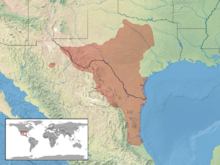Plestiodon tetragrammus
| Four-lined skink | |
|---|---|

| |
| Plestiodon t. tetragrammus, municipality of Aldama, Tamaulipas, Mexico | |
| Scientific classification | |
| Domain: | Eukaryota |
| Kingdom: | Animalia |
| Phylum: | Chordata |
| Class: | Reptilia |
| Order: | Squamata |
| Family: | Scincidae |
| Genus: | Plestiodon |
| Species: | P. tetragrammus
|
| Binomial name | |
| Plestiodon tetragrammus Baird, 1859
| |

| |
| Synonyms | |
| |
The four-lined skink (Plestiodon tetragrammus)[2] is a species of lizard, which is endemic to North America. It is a medium-sized member of the Plestiodon skinks.
Taxonomy[edit]
At least two subspecies are recognized, including the nominotypical subspecies:
- Long-lined skink, P. t. tetragrammus Baird, 1859
- Short-lined skink, P. t. brevilineatus (Cope, 1880)
Some herpetologists also consider the mountain skink (Plestiodon callicephalus) to be a subspecies of Plestiodon tetragrammus under the name P. t. callicephalus. Others, however, prefer to treat the mountain skink as a distinct species because its range is geographically distinct and there are morphological differences.
Description[edit]
The two subspecies can be distinguished by their color and their stripes. The long-lined skink is gray to light brown in color and has light stripes from the eyes extending to beyond its forelegs, whereas the short-lined skink is darker in color and has stripes that end before the forelegs.
Juveniles of both subspecies have — like many Plestiodon — a blue tail; this color fades with age.
Adults reach a maximum SVL (Snout-Vent-Length) of some 7.5 cm (about 3 inches), and a TL (total length) of about 18 cm (7.1 in).
Geographic range[edit]
Plestiodon tetragrammus occurs in northern Mexico and along the Mexican Gulf coast and in western and central Texas.
Habitat[edit]
Both subspecies live in lightly wooded areas, with the short-lined skink having a preference for rocky areas, whereas the long-lined skink is also found in grasslands.
Reproduction[edit]
The female lays about 5 to 12 eggs once a year, which she broods. Males develop orange (short-lined skink) to red (long-lined skink) coloration of the head during the breeding season.
References[edit]
- ^ Hammerson, G.A.; Lavin, P. & Mendoza-Quijano, F. (2007). "Plestiodon tetragrammus". The IUCN Red List of Threatened Species. 2007. IUCN: e.T64241A12757814. doi:10.2305/IUCN.UK.2007.RLTS.T64241A12757814.en. Retrieved 9 January 2018.
- ^ Plestiodon tetragrammus, The Reptile Database
Further reading[edit]
- Baird, S.F. 1859. Descriptions of New Genera and Species of North American Lizards in the Museum of the Smithsonian Institution. Proc. Acad. Nat. Sci. Philadelphia "1858" [10]: 253-256. ("Plestiodon tetragrammus, Baird", p. 256.)
- Behler, J.L., and F.W. King. 1979. The Audubon Society Field Guide to North American Reptiles and Amphibians. Knopf. New York. 743 pp. ISBN 0-394-50824-6. (Eumeces tetragrammus, pp. 577–578.)
- Boulenger, G.A. 1887. Catalogue of the Lizards in the British Museum (Natural History). Second Edition. Volume III. Lacertidæ, Gerrhosauridæ, Scincidæ,... Trustees of the British Museum (Natural History). (Taylor and Francis, printers.) London. xii + 575 pp. + Plates I.- XL. (Eumeces tetragrammus, pp. 375–376.)
- Conant, R. 1975. A Field Guide to Reptiles and Amphibians of Eastern and Central North America, Second Edition. Houghton Mifflin. Boston. xviii + 429 pp. ISBN 0-395-19979-4 (hardcover), ISBN 0-395-19977-8 (paperback). (Eumeces tetragrammus, pp. 125–126 + Plate 19 + Map 82.)
- Cope, E.D. 1880. On the Zoological Position of Texas. Bull. U.S. Nat. Mus. (17): 1-51. ("Eumeces brevilineatus sp. nov.", pp. 18–19.)
- Smith, H.M., and E.D. Brodie Jr. 1982. Reptiles of North America: A Guide to Field Identification. Golden Press. New York. 240 pp. ISBN 0-307-13666-3. (Eumeces tetragrammus, pp. 76–77.)
External links[edit]
- Info on the range (Note: the western range separated from the rest is actually the range of Plestiodon callicephalus.)

